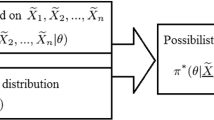Abstract
A Bayesian approach in the possibilistic environment is introduced, when the available data of the underlying statistical model are fuzzy. In this approach, based on a possibilistic model and a prior possibility distribution, the possibilistic posterior distribution is defined, when the available data are fuzzy. While the probabilistic Bayesian approach is suitable when we have stochastic uncertainty in the underlying model and available information, the proposed possibilistic Bayesian approach is proper when we come across the possibilistic uncertainty which is related to the notions of compatibility and consistency. A few numerical examples and a couple of applied examples in the field of concept learning are presented to illustrate the applicability of the proposed models.






Similar content being viewed by others
References
Alcalde C, Burusco A, Fuentes-Gonz\({\rm {\acute{a}}}\)lez R (2005) A characterization for residuated implications on \({\cal {J}}[{\text{0,1 }}]\). Application to the L-fuzzy concept theory. Mathware Soft Comput 12:155–167
Beliakov G (2005) Fitting triangular norms to empirical data. In: Logical, algebraic, analytic and probabilistic aspects of triangular norms. Elsevier, Boston, pp 262–272
Berger JO (1985) Statistical decision theory and Bayesian analysis. Springer, New York
Chen YY (1995) Statistical inference based on the possibility and belief measures. Trans Am Math Soc 347:1855–1863
Ciaramella A, Tagliaferri R, Pedrycz W (2004) Ordinal sums by using genetic algorithms. In: IEEE international conference on fuzzy systems, FUZZ-IEEE, Budapest, pp 641–646
Cui Y, Guo R, Guo D (2013) Probabilistic DEAR models. Int J Mach Learn Cybern 4:373–389
Dubois D, Prade H (1988) Possibility theory. Plenum Press, New York
Dubois D, Prade H (1997) Bayesian conditioning in possibility theory. Fuzzy Sets Syst 92:223–240
Fodor JC, Roubens M (1994) Fuzzy preference modeling and multicriteria decision support. Kluwer Academic Publishers, Dordrecht
Fr\({\rm \ddot{u}}\)hwirth-Schnatter S (1993) On fuzzy Bayesian inference. Fuzzy Sets Syst 60:41–58
Gil MA, Corral N, Gil P (1985) The fuzzy decision problem: an approach to the point estimation problem with fuzzy information. Eur J Oper Res 22:26–34
Hareter D, Viertl R (2004) Fuzzy information and Bayesian statistics. In: Lopez-Diaz M et al (eds) Soft methodology and random information systems. Springer-Verlag, Berlin, pp 392–398
He YL, Wang R, Kwong S, Wang XZ (2014) Bayesian classifiers based on probability density estimation and their applications to simultaneous fault diagnosis. Inf Sci 259:252–268
Hisdal E (1978) Conditional possibilities independence and noninteraction. Fuzzy Sets Syst 1:283–297
Jiang L, Cai Z, Wang D, Zhang H (2013) Bayesian citation-KNN with distance weighting. Int J Mach Learn Cybern doi:10.1007/s13042-013-0152-x
Katagiri H, Uno T, Kato K, Tsuda H, Tsubaki H (2014) Random fuzzy bilevel linear programming through possibility-based value at risk model. Int J Mach Learn Cybern doi:10.1007/s13042-012-0126-4 (to appear)
Klir GJ, Folger TA (1988) Fuzzy sets, uncertainty, and information. Prentice-Hall, Engle-wood Cliffs, New Jersey
Lapointe S, Bobee B (2000) Revision of possibility distribution: a Bayesian inference pattern. Fuzzy Sets Syst 116:119–140
Mitchell TM (1997) Machine learning. McGraw Hill, New York
Okuda T, Tanaka H, Asai L (1978) A formulation of fuzzy decision problems with fuzzy information using probability measures of fuzzy events. Inf Control 38:135–147
Smets P (1982) Possibilistic inference from statistical data. In: Proceedings of the 2nd World conference on mathematics at the service of man, Las Palmas, pp 611–613
Subrahmanya N, Shin YC (2013) A variational Bayesian framework for group feature selection. Int J Mach Learn Cybern 4(6):609–619
Taheri SM, Behboodian J (2001) A Bayesian approach to fuzzy hypotheses testing. Fuzzy Sets Syst 123:39–48
Taheri SM, Behboodian J (2006) On Bayesian approach to fuzzy testing hypothesis with fuzzy data. Ital J Pure Appl Math 19:139–154
Taheri SM, Zarei R (2011) Bayesian system reliability assessment under the vague environment. Appl Soft Comput 11:1614–1622
Tanaka H, Okuda T, Asai K (1979) Fuzzy information and decision in a statistical model. In: Gupta MM et al (eds) Advances in fuzzy set theory and applications. North-Holland, Amsterdam, pp 303–320
Trillas E, Alsina C, Pradera A (2004) On MPT-implication functions for fuzzy logic. Rev R Acad Cien Ser A Math 98:259–271
Viertl R (2011) Statistical methods for fuzzy data. Wiley, Chichester
Viertl R (1997) On statistical inference for non-precise data. Environmetrics 8:541–568
Viertl R, Hareter D (2004) Fuzzy information and stochastics. Iran J Fuzzy Syst 1:43–56
Wang S, Watada J (2013) Capacitated two-stage facility location problem with fuzzy costs and demands. Int J Mach Learn Cybern 4:65–74
Wang XZ, He YL, Wang DD (2014) Non-naive Bayesian classifiers for classification problems with continuous attributes. IEEE Trans Cybern 44(1):21–39
Zadeh LA (1978) Fuzzy sets as a basis for a theory of possibility. Fuzzy Sets Syst 1:3–28
Zadeh LA (1968) Probability measures of fuzzy events. J Math Anal Appl 23:421–427
Zadeh LA (1995) Probability theory and fuzzy logic are complementary rather than competitive. Technometrics 37:271–276
Acknowledgments
The authors wish to express their thanks to the referees for valuable comments which improved the paper. They would like to thank Professor Radko Mesiar (at Bratislava University of Technology) for reading the manuscript and for his valuable comment and suggestion which is considered in Remark 9. Also, they express their thanks to Dr. M.M. Pedram (at Kharazmi University) for introducing and providing some necessary reference books. The authors would like to acknowledge the financial support of University of Tehran for this research under grant number 30005/1/01.
Author information
Authors and Affiliations
Corresponding author
Rights and permissions
About this article
Cite this article
Arefi, M., Taheri, S.M. Possibilistic Bayesian inference based on fuzzy data. Int. J. Mach. Learn. & Cyber. 7, 753–763 (2016). https://doi.org/10.1007/s13042-014-0291-8
Received:
Accepted:
Published:
Issue Date:
DOI: https://doi.org/10.1007/s13042-014-0291-8




